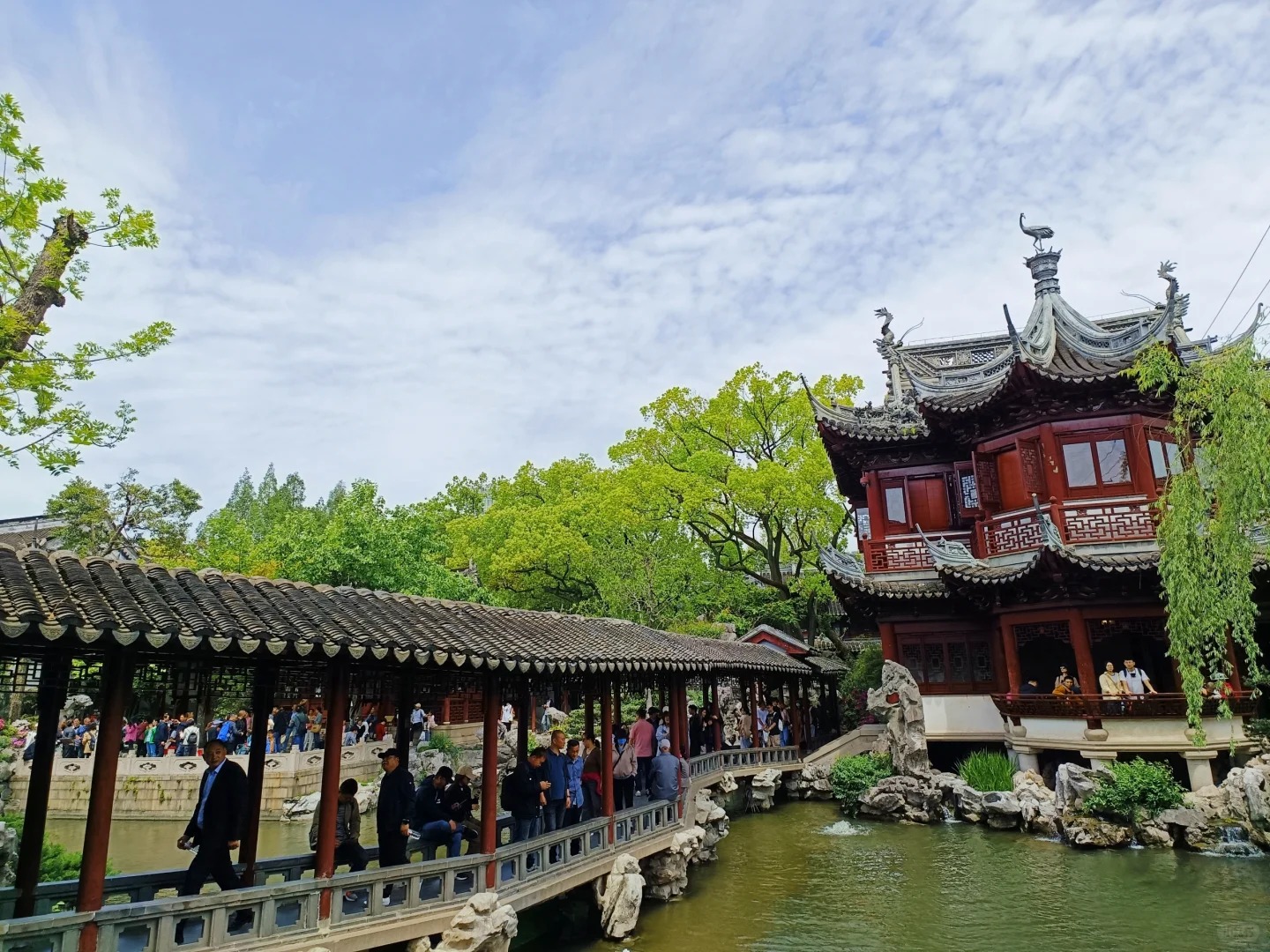Visiting Information
| Information | Details |
|---|---|
| Chinese Name | 豫园 (Yù Yuán) |
| Location and Address | 218 Anren Street, Huangpu District, Shanghai, China |
| Opening Hours | 8:30 AM – 5:30 PM (Last entry at 5:00 PM) |
| Entrance Fee | 40 CNY (April 1 – June 30, September 1 – November 30) 50 CNY (July 1 – August 31) 30 CNY (December 1 – March 31) |
| How to Get There | By Metro: Line 10 to Yuyuan Garden Station, Exit 1 By Bus: Take bus 11, 26, 64, 66, 736, 920, 926 or 930 to Yu Garden By Taxi: Available from anywhere in Shanghai |
| Best Time for Visit | Spring (March to May) and Autumn (September to November) |
| Contact Info | Phone: +86 21 6326 0830 Email: [email protected] |
Overview
Yu Garden, also known as Yuyuan Garden, is an extensive Chinese garden located in the Old City of Shanghai. It is a popular classical garden that has a history of more than 400 years. Occupying an area of 20,000 square meters (about 5 acres), Yu Garden showcases the quintessence of traditional Chinese garden architecture, with its intricate design, exquisite sculptures, and rich cultural connotations.
Historical Background
Yu Garden was first built in 1559 during the Ming Dynasty by Pan Yunduan, a high-ranking official, as a private garden for his parents to enjoy in their old age. The construction took nearly 20 years and cost Pan Yunduan’s entire family fortune. However, the garden fell into disrepair shortly after its completion due to the decline of Pan’s family. Over the centuries, the garden changed hands multiple times and suffered damage during various wars and occupations. It was fully restored and opened to the public in 1961. Today, it stands as a precious remnant of Ming Dynasty garden design in Shanghai’s bustling urban landscape.

Architectural Features
- Jade Rock: This 5-ton boulder is the centerpiece of Yu Garden. Legend has it that it was meant for the imperial palace in Beijing but was salvaged from a sunken ship. The rock is full of holes, and when water is poured on top, it flows out of each layer creating a mesmerizing effect.
- Dragon Wall: This unique wall features two dragon heads facing each other, with a pearl in between. It’s said that this design was meant to prevent fire, as dragons are associated with water in Chinese mythology.
- Exquisite Jade Rock Hall: This hall houses the famous Jade Rock and is surrounded by beautiful ginkgo trees. Its unique roof design and intricate wood carvings make it a standout feature of the garden.
- Mid-Lake Pavilion Teahouse: Built on stilts above a pond, this is one of the oldest teahouses in Shanghai. It’s connected to the rest of the garden by the Nine-Turning Bridge, designed with zigzags to supposedly confuse evil spirits.
- Hall of Heralding Spring: This is the largest and most ornate structure in Yu Garden. It features a magnificent roof with upturned eaves and intricate carvings, representing the height of Ming Dynasty architecture.
Cultural Importance
Yu Garden holds immense cultural significance as a prime example of classical Chinese garden design from the Ming Dynasty. It embodies the Suzhou-style garden aesthetic, which emphasizes the harmony between man-made structures and nature. The garden’s layout, with its winding paths, strategically placed rocks, and carefully curated plant life, reflects traditional Chinese philosophy and aesthetics. Yu Garden has also played a role in Shanghai’s modern history, serving as a base for the Small Swords Society during their uprising against the Qing government in 1853. Today, it stands as a cultural landmark, offering visitors a glimpse into China’s rich architectural and horticultural heritage amidst Shanghai’s modern cityscape.
Surrounding Attractions
- City God Temple: Located adjacent to Yu Garden, the City God Temple is a Taoist temple that has been a significant religious site in Shanghai for over 600 years. It’s known for its beautiful architecture and bustling atmosphere, especially during traditional Chinese festivals.
- Yu Garden Bazaar: Surrounding Yu Garden is a bustling marketplace filled with traditional Chinese architecture. Here, visitors can find a wide array of shops selling everything from local snacks and tea to traditional crafts and souvenirs.
- Huxinting Teahouse: This famous teahouse, built in the middle of a lake and accessed by a zigzag bridge, is one of the oldest teahouses in Shanghai. It offers a tranquil setting to enjoy traditional Chinese tea and snacks.
- Xiaotaoyuan Mosque: A short walk from Yu Garden, this mosque is one of the most important Islamic places of worship in Shanghai. Its unique blend of Chinese and Islamic architectural styles makes it an interesting cultural landmark.

Photography Opportunities
- Dragon Wall: The iconic dragon wall offers excellent opportunities for close-up detail shots. The intricate design and symbolism make for compelling photographic subjects, especially when lit by morning or late afternoon light.
- Jade Rock: This centerpiece of the garden provides interesting compositional opportunities. Photographers can capture its unique texture and the way light plays off its numerous holes and crevices.
- Mid-Lake Pavilion: The reflections of this pavilion in the surrounding water create beautiful symmetrical compositions, especially on calm days. The zigzag bridge leading to it also offers interesting leading lines for photographs.
- Traditional Architecture: The ornate roofs, intricate wood carvings, and lattice windows throughout the garden provide endless opportunities for architectural detail shots. The interplay of light and shadow can create dramatic effects, particularly in the early morning or late afternoon.
- Seasonal Beauty: Yu Garden’s appearance changes with the seasons, offering diverse photographic opportunities year-round. Spring brings blooming flowers, summer offers lush greenery, autumn provides colorful foliage, and winter occasionally offers a rare snowy scene in Shanghai.
Modern Importance
- Cultural Preservation: Yu Garden serves as a living museum of Ming Dynasty garden design and architecture. Its preservation and ongoing restoration efforts highlight China’s commitment to maintaining its cultural heritage in the face of rapid urban development.
- Tourism: As one of Shanghai’s top tourist attractions, Yu Garden plays a significant role in the city’s tourism industry. It attracts millions of visitors annually, contributing to the local economy and helping to showcase Shanghai’s rich history to international visitors.
- Education: The garden serves as an important educational resource, offering visitors, especially students, a tangible connection to China’s past. It provides insights into traditional Chinese philosophy, architecture, and garden design principles.
- Urban Green Space: In the heart of one of the world’s largest cities, Yu Garden provides a much-needed green space. It offers locals and tourists alike a peaceful retreat from the bustling urban environment, contributing to the city’s livability and environmental quality.
- Cultural Events: Yu Garden hosts various cultural events and festivals throughout the year, such as the Lantern Festival celebrations. These events help to keep traditional Chinese culture alive and relevant in modern Shanghai.

FAQ
- What is Yu Garden famous for?
Yu Garden is famous for its classical Chinese garden design, intricate architecture, and historical significance. It’s particularly renowned for its Jade Rock, Dragon Wall, and traditional Ming Dynasty style pavilions and halls. - What’s inside Yu Garden?
Inside Yu Garden, visitors can find traditional Chinese pavilions, halls, rockeries, ponds, and bridges. Key features include the Jade Rock, Exquisite Jade Rock Hall, Dragon Wall, Mid-Lake Pavilion Teahouse, and the Hall of Heralding Spring. - Is Yu Garden free?
No, Yu Garden is not free. There is an entrance fee that varies depending on the season, ranging from 30 to 50 CNY. - Is Yu Garden worth visiting?
Yes, Yu Garden is generally considered worth visiting. It offers a unique glimpse into traditional Chinese garden design and architecture, and provides a peaceful retreat in the heart of bustling Shanghai. - What to do in Yu Garden?
Visitors can explore the various pavilions and halls, admire the Jade Rock, walk across the Nine-Turning Bridge, enjoy tea at the Mid-Lake Pavilion Teahouse, and take in the intricate details of classical Chinese garden design. - How do I get to Yu Garden in the local city?
In Shanghai, you can reach Yu Garden by taking Metro Line 10 to Yuyuan Garden Station and exiting from Exit 1. Alternatively, several bus lines stop near Yu Garden, including 11, 26, 64, 66, 736, 920, 926, and 930. Taxis are also readily available from anywhere in the city. - How to visit Yu Garden?
To visit Yu Garden, purchase tickets at the entrance. It’s advisable to arrive early to avoid crowds, especially during peak tourist seasons. Consider hiring a guide or using an audio guide to learn about the history and significance of different areas. Wear comfortable shoes as there’s a lot of walking involved. Allow at least 2-3 hours for your visit to fully appreciate the garden’s beauty and intricacy.





